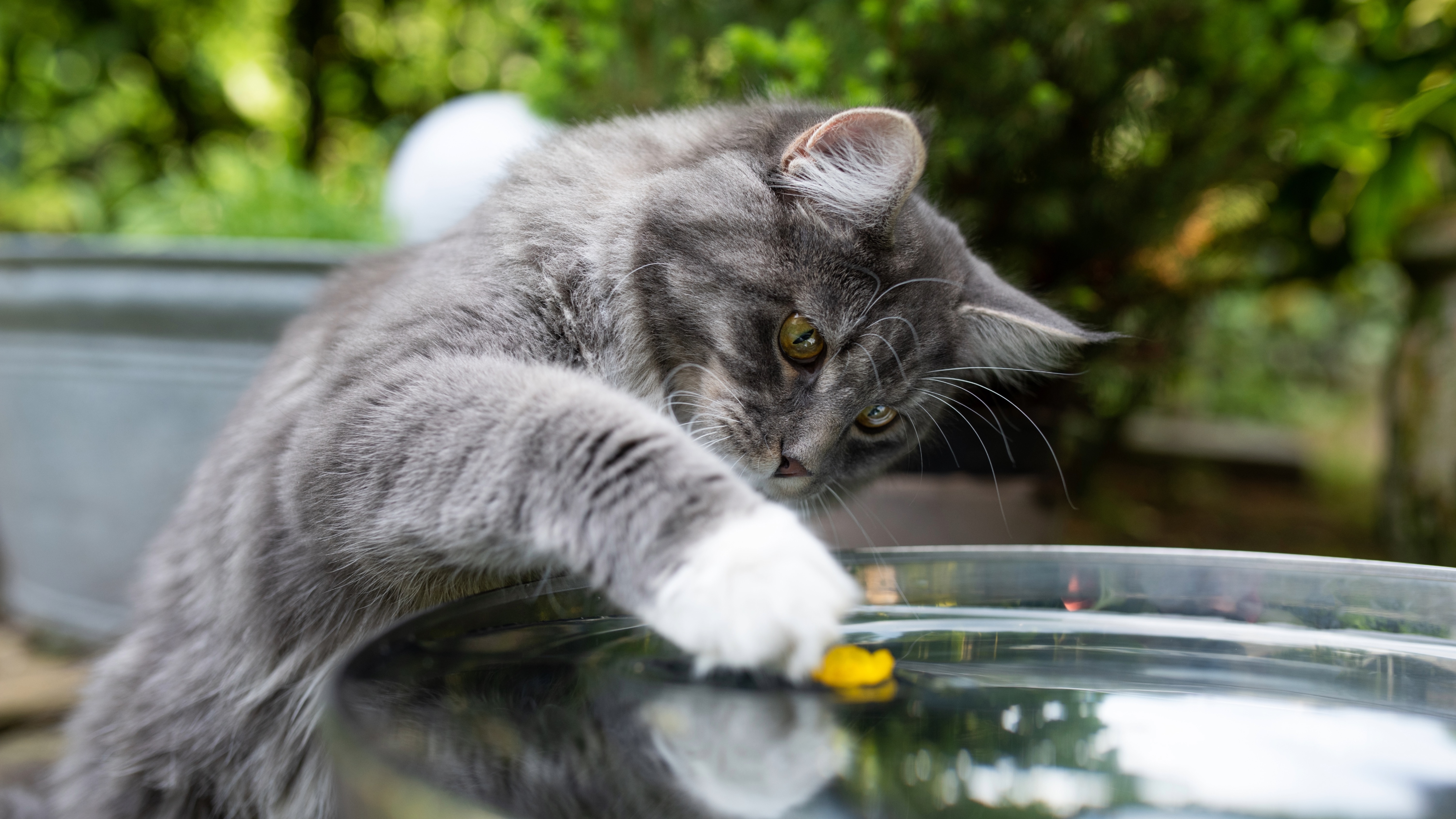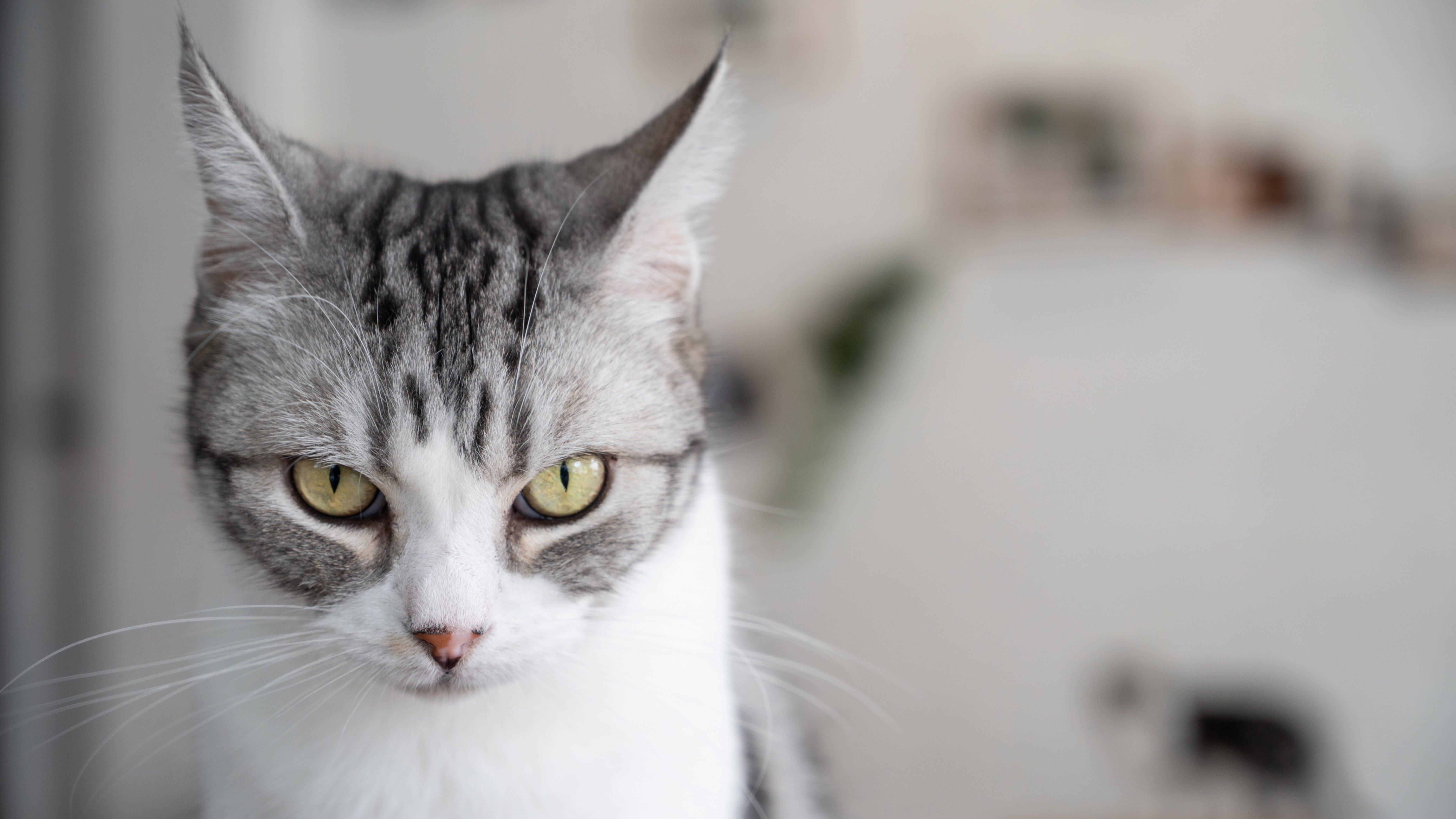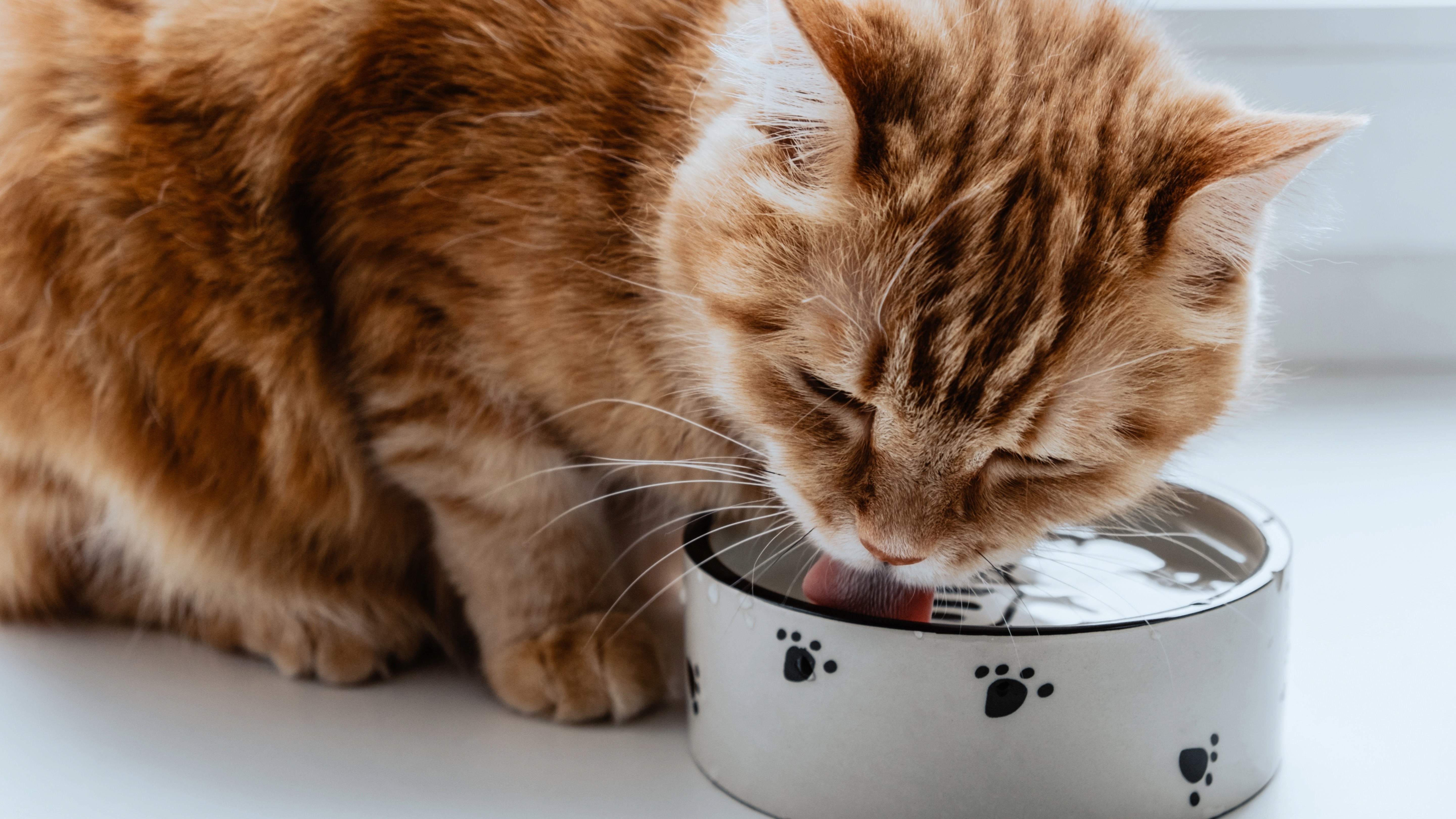
Why does my cat paw at her water bowl? It’s a question that may be on your mind if your kitty seems to enjoy playing with their water more than drinking it. But rest assured, while cleaning up the water on your floor is no doubt a job you could do without, this behavior is completely normal for our feline friends and is usually nothing to worry about.
Alongside feeding your kitty a diet of the best cat food, providing them with a clean and fresh water source is super important for their health and wellbeing. It’s particularly vital if you fill their bowl with the best dry cat food as kibble lacks the moisture found in wet food. However, if your beloved ball of fluff spends more time playing with their water than drinking it, what’s a concerned pet parent to do?
Well, according to expert vet Dr. Rebecca MacMillan, there are lots of reasons a cat may paw at their water bowl and while most of them are harmless, it’s worth paying attention to this behavior and ensuring it’s not accompanied by any other concerning symptoms (such as overgrooming or excessive vocalization).
To help you figure out when this behavior is a cause for concern and when it’s just your cat being a cat, we asked Dr. MacMillan to outline the various reasons your kitty may be splashing their water about. Plus, she reveals the signs to be on the lookout for that suggest your cat may need to see a vet and whether there’s anything you can do to put a stop to all that water that’s ending up on your floor!
Why does my cat paw at her water bowl?
While it would be easy to chalk it up to mischief-making on the part of our feline friends, you might be surprised to learn that there are a number of reasons that can drive a kitty to want to paw at their water bowl or fountain. Here are six of the most common:
1. Cats love moving water
It’s true - our feline friends can’t get enough of the free-flowing cold stuff! This love of moving water is deeply embedded into their DNA and is one of nature's very sophisticated survival strategies. Wild cats view still and stagnant water as potentially being contaminated with bacteria that could kill them, whereas moving water is seen as being fresh and therefore safe to drink.
"Cats are instinctively drawn to flowing water, which is more likely to be fresh and safe than still water," confirms MacMillan. "Moving it around with their paw may help to replicate this."
While your kitty is living a life of comfort in your home and certainly doesn’t need to worry about their life being cut short by drinking from their water bowl, it’s still in their nature to view unmoving water with suspicion. Pawing at their water bowl makes the contents more enticing by getting the flow of water to mimic what they would see if they were drinking from a river or stream.
Sometimes this behavior is best chalked up to one of those funny things cats do!
2. Whisker fatigue
Although pawing at their water bowl or fountain could be a sign of contentment and pleasure, it can also be a sign of discomfort caused by whisker fatigue.
What is whisker fatigue we hear you ask? While it may sound like a strange name, whisker fatigue is a very real and painful condition that makes your cat’s whiskers super sensitive to even the slightest touch.
"A cat’s whiskers are extremely sensitive and can go into sensory overload when continually touched (for example being pressed against the side of a food or water dish as they lower their head into it)," MacMillan explains. "So, some cats may splash water around to avoid having to put their whiskers into their dish again."
Most cats have around 24 whiskers placed strategically above the eyes, on the chin, near the ears and above the upper lip. The whiskers that sit above the top lip on either side of their nose are known as mystacial whiskers and these are equipped with sensory organs that help your cat to identify the width of an object.
When it comes to what kind of bowl is best for cats, wide and shallow is the ideal way to go. Narrow and deep bowls mean your cat’s whiskers will frequently touch the sides, which puts pressure on the sensory organs, triggering pain and discomfort and causing your kitty to try to paw the water into their mouth instead of lapping it up with their tongue.
3. Stress or anxiety

Stress and anxiety in cats are two other common causes of pawing behavior. Believe it or not, just like dogs, many cats miss their owners and they may become stressed if they’re left alone for long periods of time. This is usually seen in highly social breeds who thrive on human contact, but it can affect any cat.
"When a cat is feeling stressed or anxious, they may start displaying unusual
behaviors including pawing at their bowl or water fountain," explains MacMillan. "Other symptoms of stress include hiding away, over-grooming, aggression, scratching in the house, and inappropriate toileting."
You may also find that changes to your cat’s routine can trigger pawing behavior as well. Our feline friends are real creatures of habit and don’t take kindly to disruptions. Triggers for stress and anxiety can include home renovations, moving house, having a new child or animal in the home, their feeding schedule changing or their litter box being moved.
One of the best ways to bond with your cat and keep your relationship strong is to try to keep disruptions to a minimum. If that's not possible, try to keep your cat's routine as consistent as you can and create a safe and quiet space they can retreat to if they're in need of a break.
4. Compulsive behavior
Yes, believe it or not, obsessive compulsive disorder (OCD) can affect cats as well as humans and may drive your kitty to engage in repetitive and exaggerated behaviors that serve no purpose. Things like overgrooming, licking or chewing on fabric, tail chasing, frequent pacing and pawing at their water bowl are all potential signs that your feline may be suffering from OCD.
"For some cats, repetitive actions can become an ingrained habit. Stress or anxiety could again be an underlying cause for strange obsessive behaviors," confirms MacMillan.
5. It’s a territorial instinct
If you have more than one feline furkid, you may have noticed that they can sometimes become territorial when it comes to their food or the best cat toys that you’ve picked out for them. Cats aren’t particularly fond of sharing and because their paws contain scent glands, they will often use their paw to deposit their scent into the water to deter other cats from drinking out of their bowl.
6. They’re playing
Finally, according to MacMillan, cats often paw at their water bowl or fountain for the pure joy of it. "One of the most common reasons for pawing at a water dish is play. They may just enjoy the sensation and mess it creates!," she says.
This makes sense given that there's nothing our feline friends love more than a good play session. And if we're too busy to play with them, they do a great job of finding ways to create their own fun — which is why you’ll often spot them happily moving water about in their bowl and, on occasion, splashing it about all over the floor!
Should I be worried if my cat paws at their water bowl?

Most of the time, your cat pawing at their water bowl or fountain isn’t going to be a cause for concern. It’s highly likely in most cases that your cat is engaging in this behavior because it’s a natural instinct or because they’re playing. That being said, take note if the pawing is accompanied by any of the following:
- Frequent meowing, pacing or other repetitive behaviors
- Not eating or eating less than usual
- Lethargy
- Aggression
- Showing no desire to engage with you or to play
MacMillan confirms that a trip to the vet may be warranted if your cat is pawing at their water bowl while also showing other new behaviors that are worrying. "If your cat has recently developed this behavior alongside other symptoms, then you will need to explore the issue further," she says.
"For example, if your cat seems stressed and is displaying other problems like overgrooming, vocalizing more than usual, or toileting in random places in the house, then this needs addressing. If, however, your cat is otherwise happy and content, and seems to enjoy occasionally playing with their water dish then this is not a cause for concern at all."
How can I stop my cat from pawing at their water bowl?
So, if your cat is pawing at their water bowl — is there any way you can put a stop to it? According to MacMillan, the answer depends on why they're doing it.
"First it is important to identify any obvious reasons why your cat might be pawing at their water bowl," she says. "Try and work out if there is anything that could be causing your cat to feel stressed. This could be things like a new pet or person in the home, building works, or a recent house move.
I would advise trying to alleviate the stress where possible. This may include providing calming pheromone products in the environment, providing multiple water dishes/fountains so that there is no competition for resources, and making sure your cat has places to hide if they feel like it.
You may want to consider trialing an alternative water dish, such as a wider shallower one which is less likely to cause whisker fatigue. If you think that your cat is drinking a lot of water while pawing at their dish, then this could indicate an underlying health issue and it would be a good idea to get your cat
checked over by your vet."
However, unless there’s an underlying issue that’s driving your cat to engage in pawing behavior, you don’t need to worry about trying to stop them pawing. As we’ve seen, in most cases this is very normal and common behavior, but if you feel your kitty isn’t just pawing at their water for the pleasure of it or you’re finding that more water ends up on your floors than in your kitty, there are several things you can do:
- If your cat’s pawing is likely related to their love of play, make sure to invest in a variety of cat toys to help redirect this behavior and give them an outlet for all that energy. The best automated cat toys are ideal for energetic and playful kitties, and they're brilliant if you’re out of the house a lot.
- For a cat that’s experiencing whisker fatigue, ensure you’ve got the right kind of water bowl for them if you choose not to use a fountain. Just like the best cat food bowl, look for a water bowl that’s wide and shallow to prevent their whiskers from coming into contact with the sides.
- Moving your cat’s water bowl is well worth a try if there’s a lot going on in your home right now and the current location of your cat’s water bowl or fountain is in a high-traffic area. The pawing could be a result of stress and moving it to a quiet spot in the house where your kitty is less likely to be distributed may help to stop this behavior.
Finally, your vet is a valuable resource when it comes to any concerns you might have. If you’ve tried everything and the pawing continues, it’s worth having a chat with them and seeing if they have any additional suggestions.
Want to learn more about some of your cat’s other curious behaviors and what they might be trying to tell you? We’ve got you covered in our guide to ‘why is my cat crying?’







